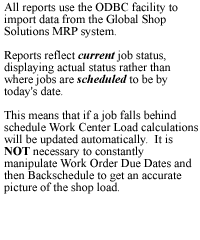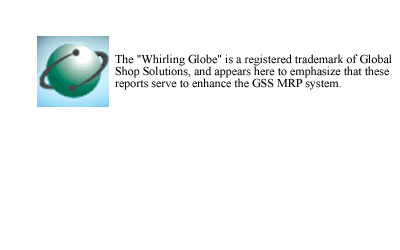Inventory
Reports


The TDASys Difference Between Scheduled and Projected Castings for Production Control.
Clearly the most powerful Production Control function in the entire Global Shop MRP system is its ability to compare the supply and demand of parts. However, raw materials with very long purchasing lead times will frequently cause problems. This is because the GSS Automatic Purchasing program bases the need for raw materials upon the demand of scheduled Work Orders. If Work Orders, and all the necessary subassembly Work Orders, are scheduled by Production Control immediately after a Sales Order is placed, then Automatic Purchasing will successfully handle raw materials with very long purchasing lead times.
However, if the Engineering Department delays the release of a Work Order - perhaps waiting for Revision changes - then Automatic Purchasing will not be aware of any demand for the raw material until after the Work Orders are scheduled. And if a required raw material has a very long purchasing lead time this frequently means that even if a Work Order is finally scheduled with enough time left to manufacture the parts, there may not be enough time to manufacture parts and order the raw materials.
The Projected demand for raw materials is calculated by taking total Sales Order Quantity for all parts and drilling down through the BOM (Bill Of Materials) file to project how many of these 'long lead time' raw materials are required to satisfy that Sales Order amount. This Projected Qty is then compared to the Scheduled Qty and to the Qty of parts on hand.
As an example, a Scheduled Qty of 50 with a Projected Qty of 75 and an On-Hand Qty of 10 indicates that Scheduled Work Orders require 50 pcs, but the total requirements will eventually be 75. There are 10 parts in stock, so the report projects that at least 65 PCs must be purchased to cover the Sales Order Qty.